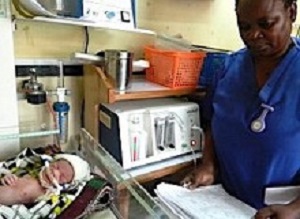Malawi's national adoption of affordable, rugged, neonatal CPAP technology as a part of routine hospital care resulted in sustained improvements in the survival of babies with respiratory illness, according to a study.
Malawi, in southeast Africa, has the world's highest pre-term birth rate, with almost 1 in 5 babies born premature. A study conducted at 26 Malawi government hospitals found that the national adoption of rugged, low-cost, neonatal "continuous positive airway pressure" (CPAP) devices improved survival rates from 49% to 55% for newborns admitted with breathing problems. For newborns with severe breathing problems, survival improved from 40% to 48%.
"For babies that had respiratory distress syndrome – these are the tiniest babies that have some of the biggest challenges with breathing – we saw a nearly a 10% improvement in survival after CPAP was available," said Rice University engineering professor Rebecca Richards-Kortum, the study's corresponding author and co-director of the Rice 360° Institute for Global Health.
The study involved 2,457 babies born at government hospitals from 2013 to 2016 and was conducted by researchers from the Malawi Ministry of Health, University of Malawi College of Medicine and the Department of Pediatrics at Queen Elizabeth Central Hospital in Blantyre, Malawi, and Rice 360°.
Rice 360° developed the Pumani CPAP machine used in the study and supported the national roll-out via a transition-to-scale grant from Saving Lives at Birth, a joint undertaking by the US Agency for International Development (USAID), the Bill & Melinda Gates Foundation and the governments of Norway, the UK, Canada and South Korea.
Rice 360° co-director Maria Oden said most sub-Saharan hospitals can't afford to bring on extra nurses or technicians, so it was important to monitor patient outcomes and see if CPAP gains were sustained over years as part of routine hospital care.
"The Malawi rollout was a nurse-led, quality improvement initiative that was directed and sustained by the Malawi Ministry of Health," Oden said. "They have shown that a low-income country can scale CPAP nationally and see dramatic and lasting improvements in newborn outcomes."
Lead author Jennifer Carns, a Rice 360° bioengineer and research scientist in Rice's Brown School of Engineering, said the study also found that babies did not get the full benefit of CPAP if they were too cold. "For infants with normal body temperatures, survival rates were 66% – more than 25% higher than those who were too cold," Carns said.
While respiratory distress is common among premature babies, so are other conditions like hyperthermia.
"There's more work to be done," Richards-Kortum said. "We know for CPAP to have its full potential, it needs to be introduced as part of a quality program that focuses on improving essential newborn care."
Abstract
Objectives: Our aim in this observational study was to monitor continuous positive airway pressure (CPAP) usage and outcomes in newborn wards at 26 government hospitals in Malawi after the introduction of CPAP as part of a quality-improvement initiative. CPAP was implemented in 3 phases from 2013 through 2015.
Methods: Survival to discharge was analyzed for neonates treated with nasal oxygen and/or CPAP with admission weights of 1 to 2.49 kg at 24 government hospitals with transfer rates <15%. This analysis includes neonates admitted with respiratory illness for 5.5 months before (621 neonates) and 15 months immediately after CPAP implementation (1836 neonates). A follow-up data analysis was completed for neonates treated with CPAP at all hospitals during an additional 11 months (194 neonates).
Results: On implementation of CPAP, survival to discharge improved for all neonates admitted with respiratory distress (48.6% vs 54.5%; P = .012) and for those diagnosed with respiratory distress syndrome (39.8% vs 48.3%; P = .042). There were no significant differences in outcomes for neonates treated with CPAP during the implementation and follow-up periods. Hypothermia on admission was pervasive and associated with poor outcomes. Neonates with normal mean temperatures during CPAP treatment experienced the highest survival rates (65.7% for all neonates treated with CPAP and 60.0% for those diagnosed with respiratory distress syndrome).
Conclusions: A nurse-led CPAP service can improve outcomes for neonates in respiratory distress in low-resource settings. However, the results show that real-world improvements in survival may be limited without access to comprehensive newborn care, especially for small and sick infants.
Authors
Jennifer Carns, Kondwani Kawaza, Sara Liaghati-Mobarhan, Aba Asibon, Mary K Quinn, Alfred Chalira, Norman Lufesi, Elizabeth Molyneux, Maria Oden, Rebecca Richards-Kortum
[link url="https://news.rice.edu/2019/09/20/malawi-study-confirms-lasting-impact-of-life-saving-technology-2/"]Rice University material[/link]
[link url="https://pediatrics.aappublications.org/content/early/2019/09/19/peds.2019-0668?sso=1&sso_redirect_count=1&nfstatus=401&nftoken=00000000-0000-0000-0000-000000000000&nfstatusdescription=ERROR%3a+No+local+token"]Paediatrics abstract[/link]

